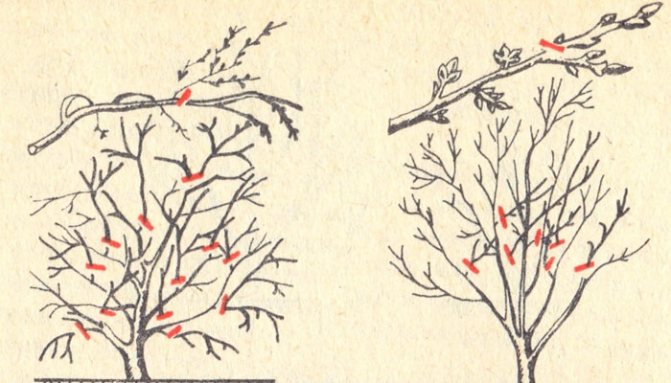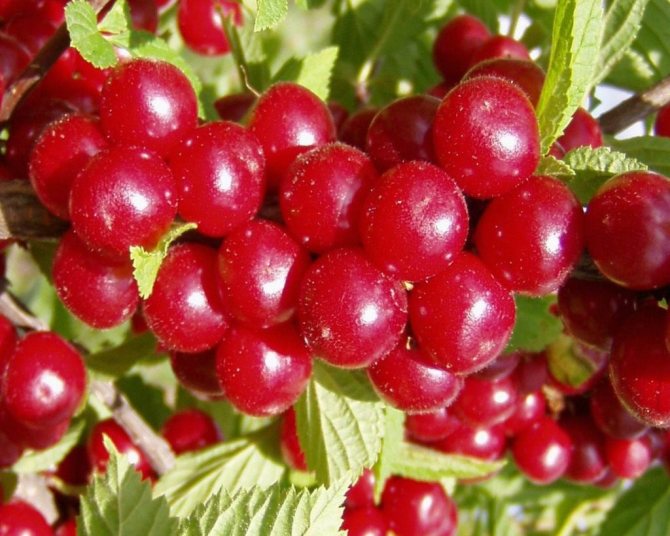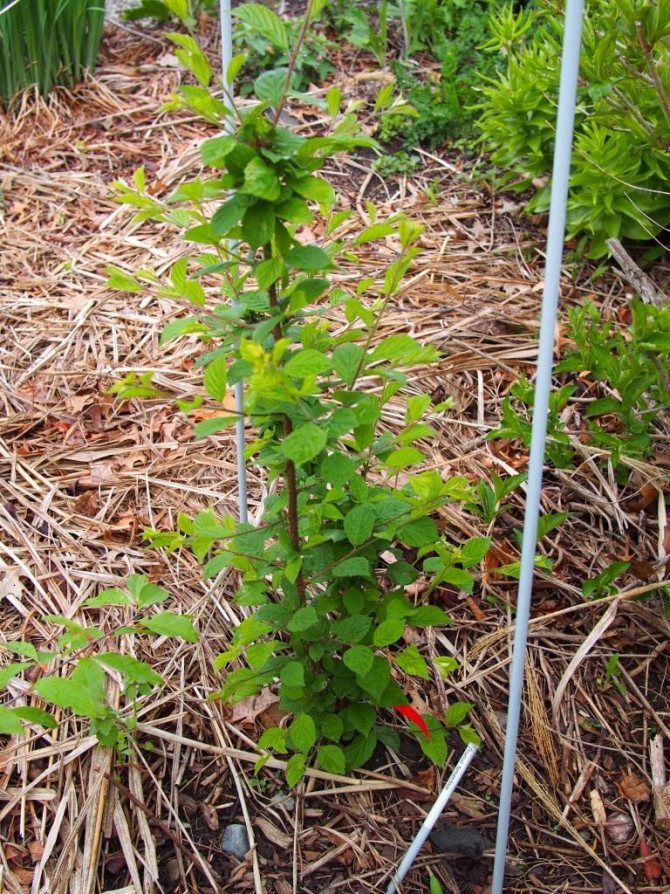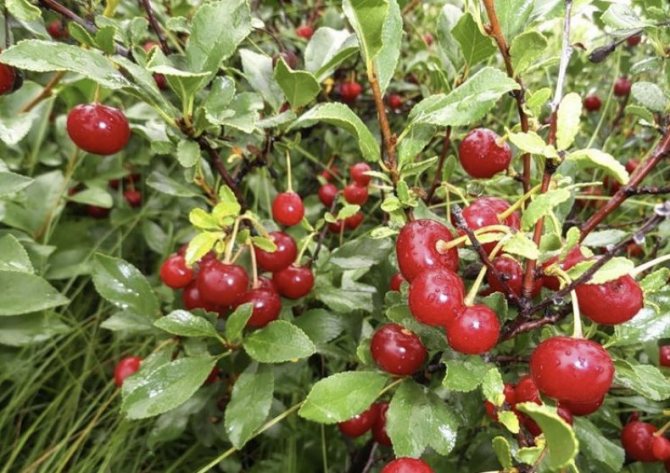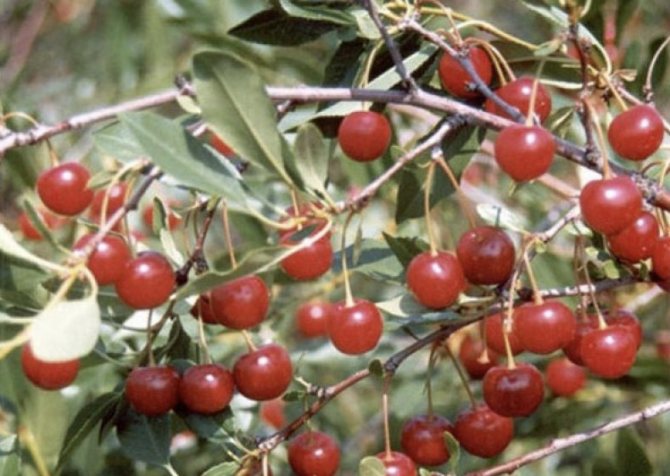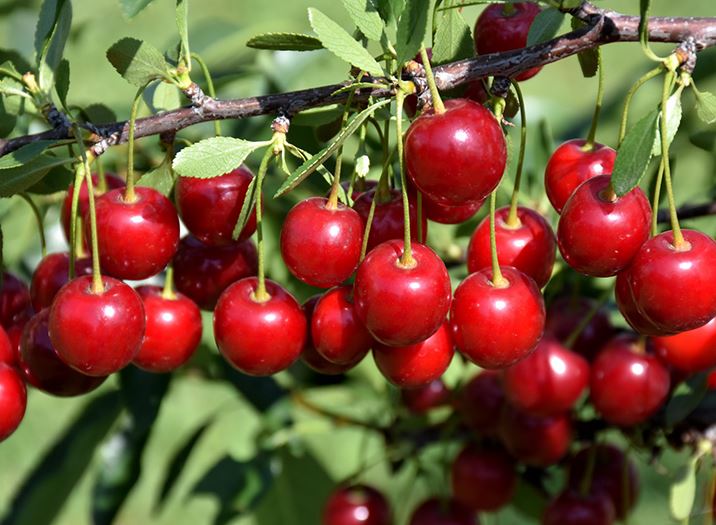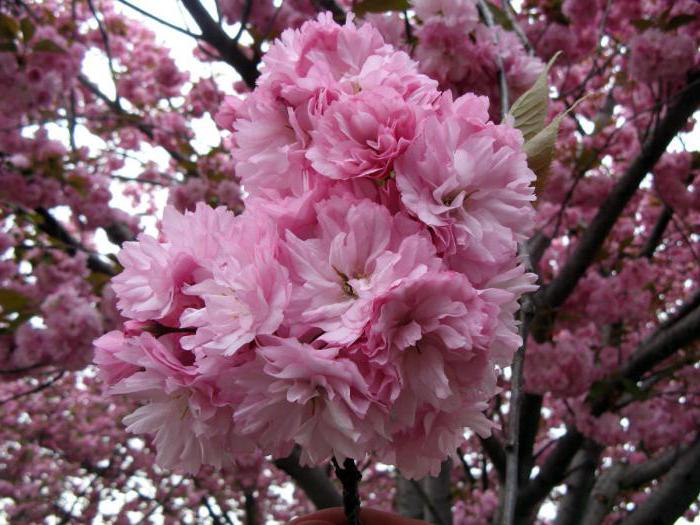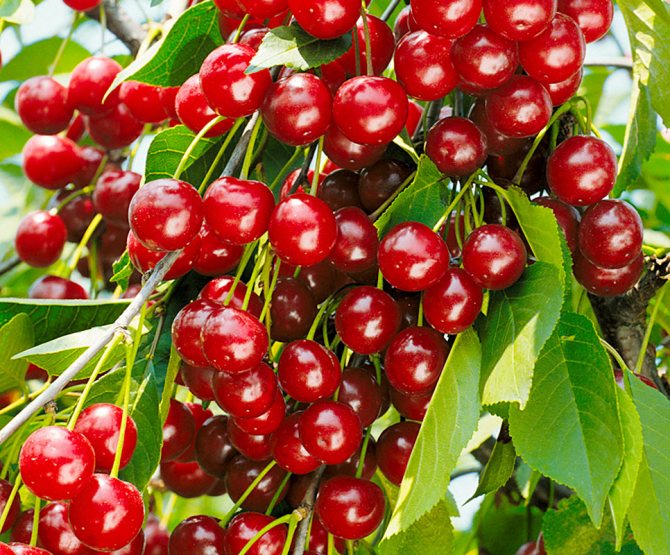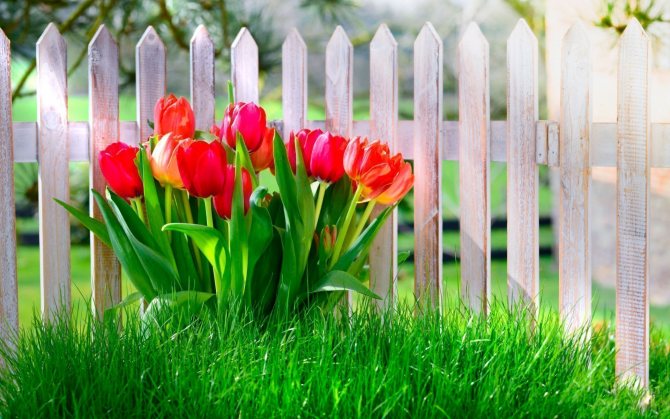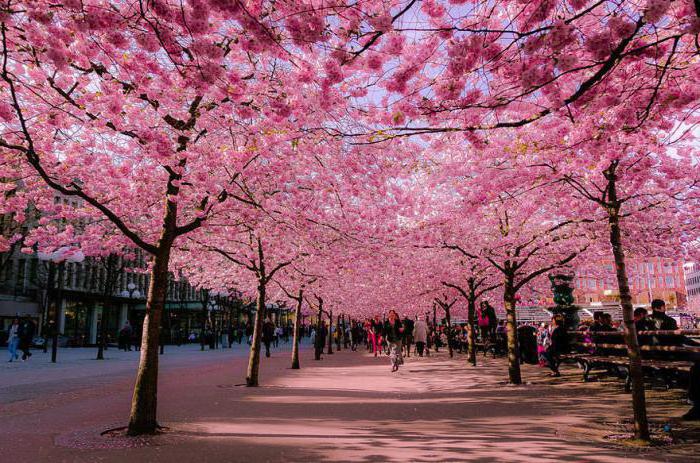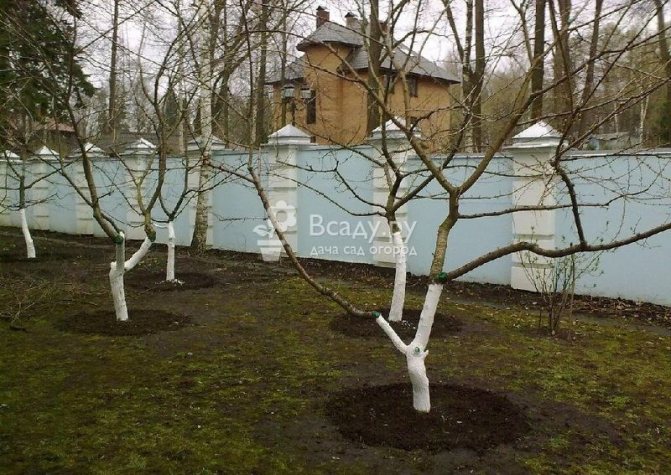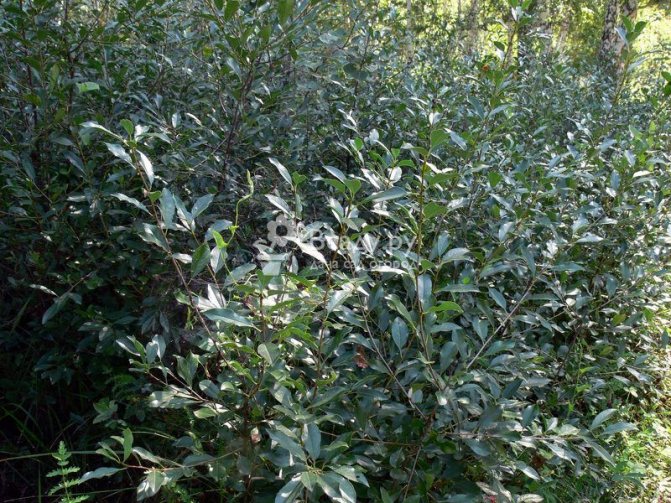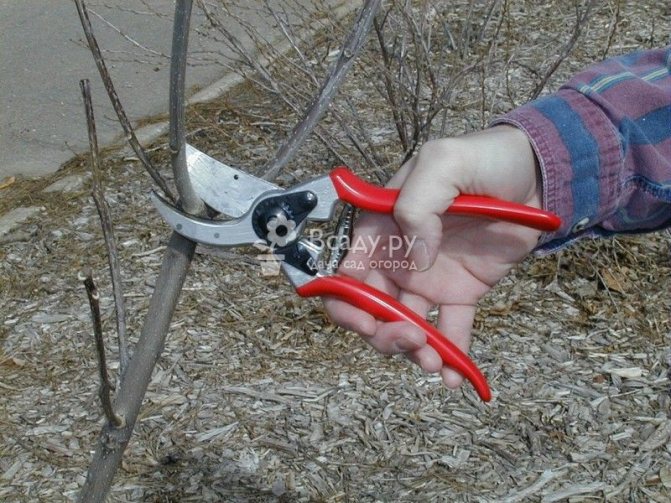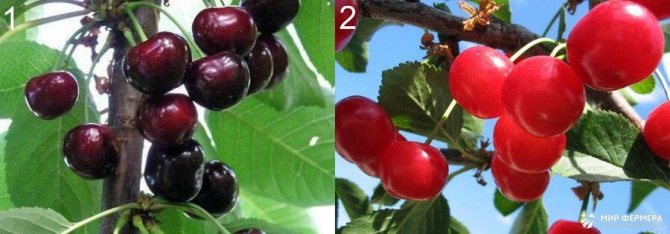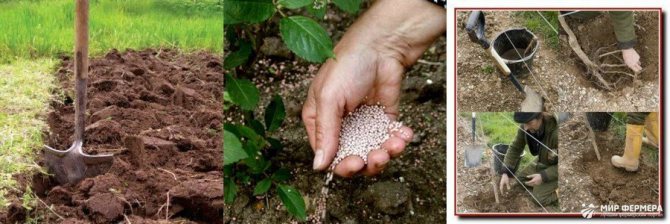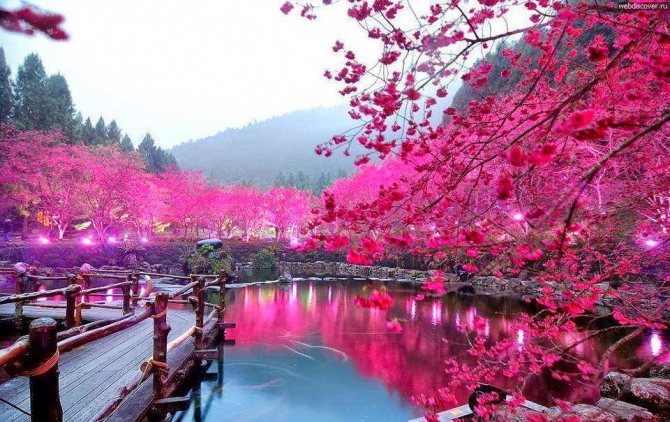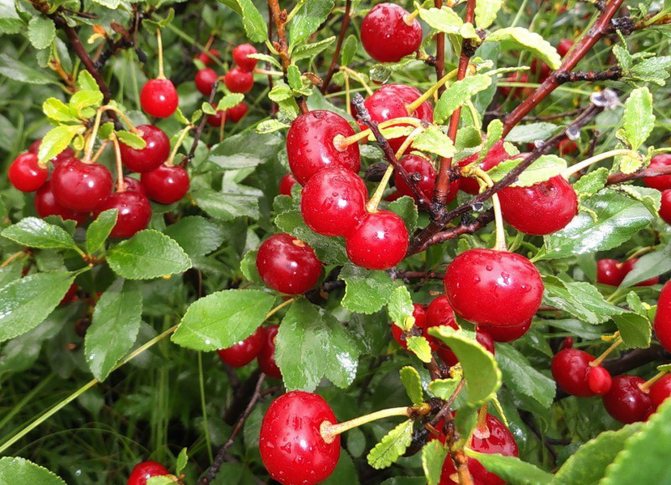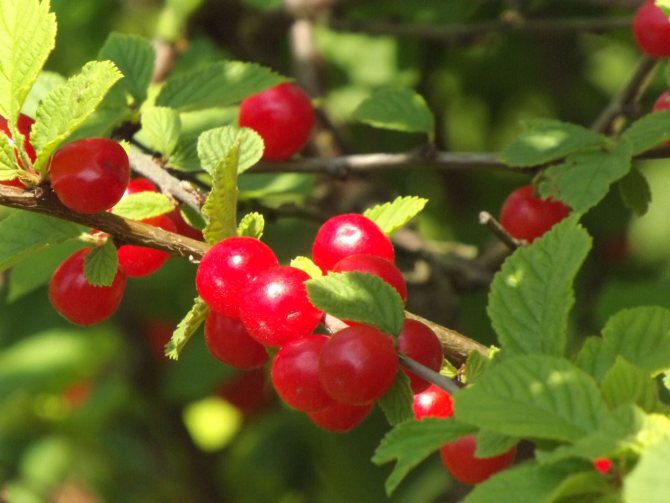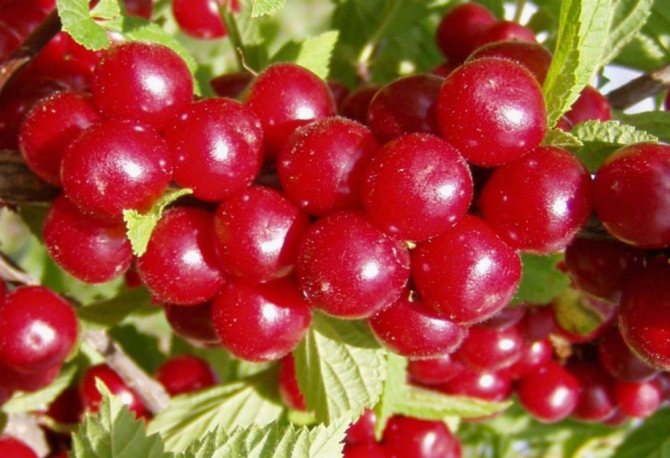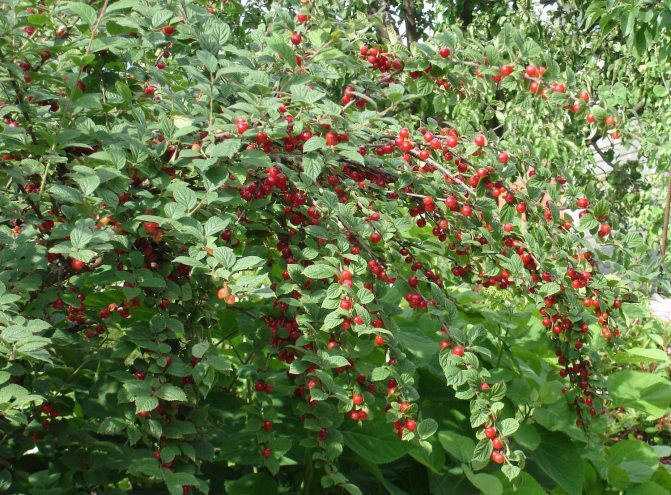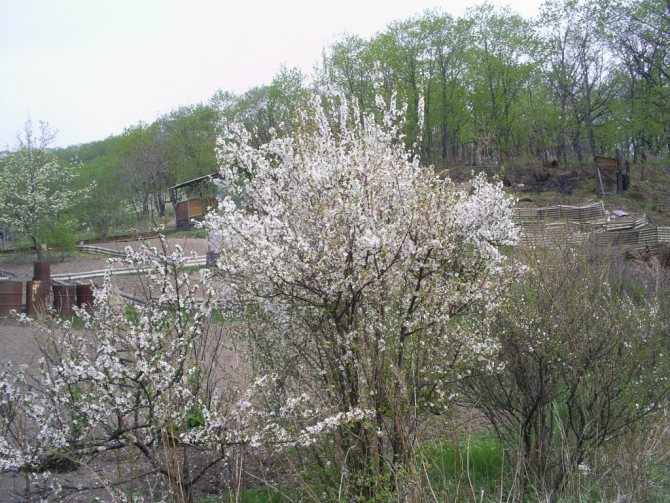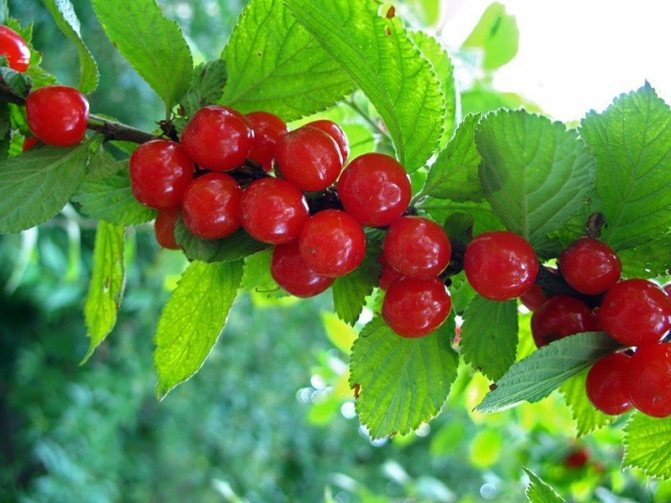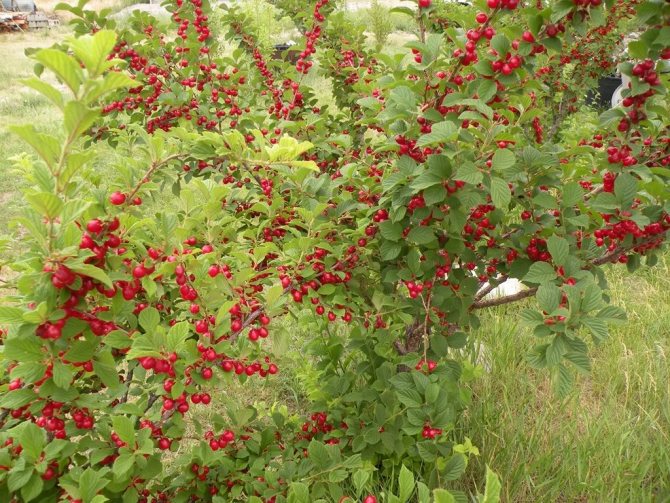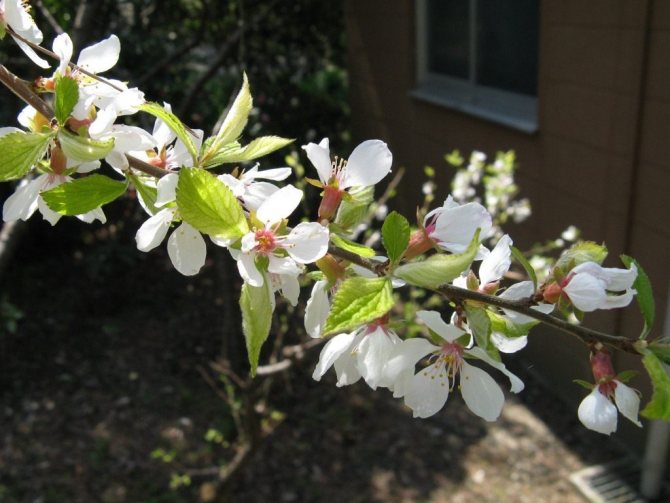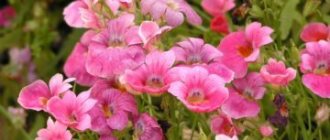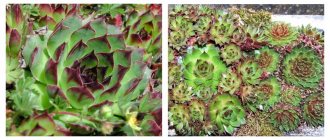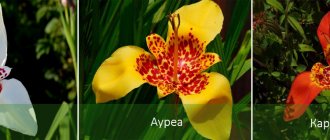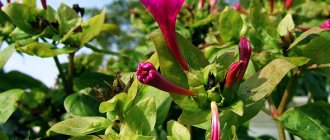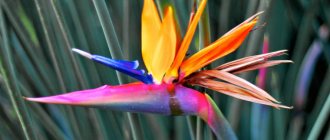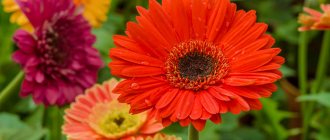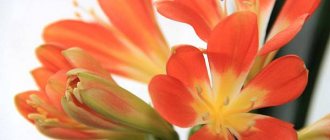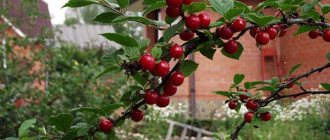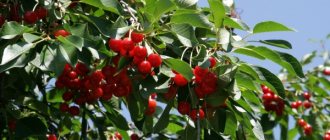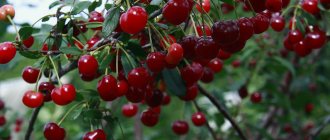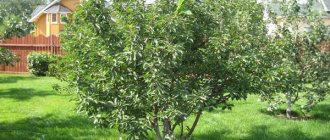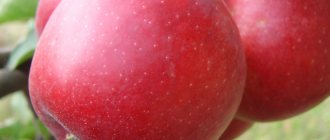- Garden
- Berry
- Blossom, cherry orchard! Growing cherries
23. 03. 2014
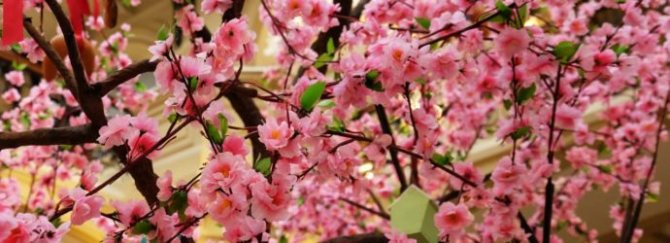
Cherry is loved for its unpretentiousness, high taste of fruits, extraordinary beauty and aroma of a flowering tree. If your dacha still doesn't have cherries, be sure to plant one, and our tips will help you do it right.
- 2 Variety for your region
2.1 For the Middle Band, these are:
- 2.2 In the southern regions, it is recommended to grow the following varieties:
- 5.1 If the cherry is unhealthy
Bushy cherry type
Bushy cherry type lays flower buds on elongated shoots in the year of their occurrence.
Flower buds in all stone fruit species are always lateral and simple, that is, they do not form replacement shoots. The elongated fruit twigs of the bushy type of cherries and plums bloom the next year, bear fruit, and become bare after harvesting. A replacement shoot arises from the apical growth bud, on which lateral flower buds are formed again. On long growths, some of the lateral buds do not differentiate into flowering buds and remain vegetative. From them, elongated branches are formed, which turn into new fruit branches.
The result is a habit typical of bush-like trees with bare long thin hanging branches. The harvest of such cherries is concentrated at the ends of the branches.
How to care?
Cherries need proper care that needs to be done regularly. Around the trunk, preventive loosening should be done so that a crust does not form, which prevents oxygen from entering the soil. The plant should be fed at least three times per season.
In autumn, superphosphates and mineral additives are added. Often, ash and onion husks are used, they are also useful ingredients for the plant. It is imperative to weed and cut weeds, they can provoke active reproduction of pathogens and aphids.
The tree should be watered in the warm season at least three times per season. Watering should be done during the period of fruit formation, as well as before the onset of cold weather. Cherry processing is carried out with special compounds, the main enemies of the plant are coccomycosis and aphids.
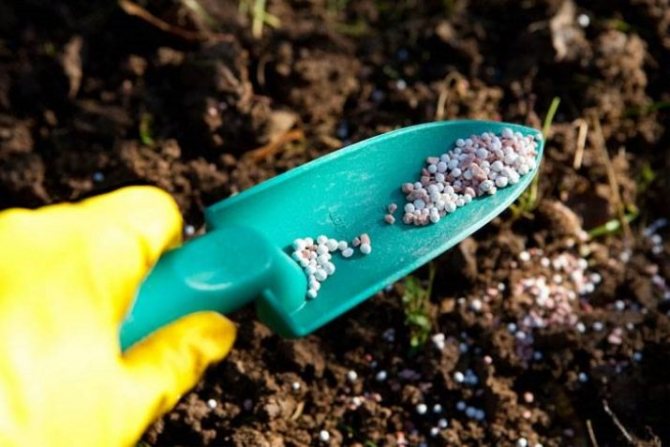

Pruning correctly in the spring is essential. Thanks to this operation, a beautiful crown is formed, which:
- provides correct, uniform illumination;
- allows you to collect fruits without any effort;
- makes it possible to regularly perform preventive care.
When pruning branches, it should be remembered that berries can only appear on shoots that have already been in the past year. Widespread flowering occurs only on annual branches.
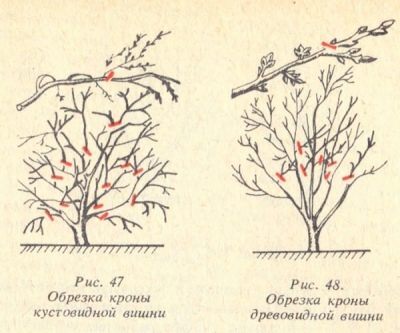

Tree type cherry
Tree type cherry rarely forms flower buds on growth shoots. If such buds arise, then in the form of group ones, among which there is a vegetative one.
The next year, a growth shoot develops from the apical bud, as in the bush type, from the majority of the lateral ones, strongly shortened shoots with leaves. By autumn, lateral buds on them differentiate into flowering buds. Bouquet twigs appear.They annually give a terminal replacement shoot several millimeters or centimeters long, and form flowers and fruits from the lateral buds.
The fruiting part of the bouquet branch is bare, but this exposure is hardly noticeable due to the small length of the branch.
The main part of the harvest in the tree type is located inside the crown. The relative durability of bouquet branches and their annual foliage contribute to the growth of skeletal and overgrown branches in thickness. As a result, the trees have raised, sparse crowns with thick, well leafy branches. In the period of fruiting, the growth of the conductors weakens. This leads to the fact that the lateral buds are able to differentiate into flowering buds with all the ensuing consequences - fruiting at the periphery of the crown, exposing the branches and drooping them.
In dry areas with low temperatures in winter, the selection of suitable horticultural crops is limited. Unpretentious and easy to care for, shrub cherry is an alternative to the ordinary tree cherry. It grows well on poor alkaline soils, easily tolerates hot summers without abundant watering, and is not sensitive to severe frosts.
Description of the plant
Why is cherry so remarkable if for thousands of years it remains one of the most popular berries in the world? According to the botanical classification, the subgenus Cherry belongs to the genus Plum, the Rosovye family. In general, about 150 varieties of this wonderful plant are known in the world. They are found in the form of tall trees and bushes. The color of the bark is from brownish brown to grayish brown. In the spring it is covered with snow-white or pinkish flowers. Leaves are elliptical from dark green to emerald, can be large and small with a jagged edge. Fruit buds are single, bunch and bouquet. The berries are colored in a wide range of red colors, from scarlet to almost black, contain an impressive list of vitamins, organic acids, antioxidants and trace elements. In folk medicine, not only fruits have long been used, but all parts of this wonderful plant. The substance found in the berries - coumarin, promotes blood clotting and is used for cardiovascular diseases. And among the people, since ancient times, cherries have been called "heart berries".
Varieties and their characteristics
Shrubs are usually called varieties bred from the wild steppe cherry, which is widespread in Western Siberia, Kazakhstan, and the European part of our country.
The common features of all varieties bred from wild bush cherry are:
- short stature, the height of the bush usually does not exceed 1.5-2 m;
- fruits are medium or small, sourish;
- spherical crown;
- abundant growth;
- high resistance to dry periods and frosty winters.
Read also How to grow champignons from seeds
Crossbreeding of the unpretentious steppe "inhabitant" with other productive representatives made it possible to obtain good resistant varieties.
The Subbotinskaya cherry deserves attention for its bright scarlet fruits with a pleasant sweet and sour taste. It is unpretentious in care, rarely grows above 2-2.5 m in height, independently forms a neat spherical crown. Requires the obligatory presence of pollinating trees on the site, the yield is high (5-9 kg).
Another interesting “descendant” of our steppe “inhabitant” is the Altayskaya Krupnaya cherry variety. Low bushes are distinguished by good yield (5-9 kg) and unpretentiousness. Large, flattened drupes are pleasant to the taste and are versatile in use. In the description of the variety, they warn that in especially frosty winters, freezing of flower buds and a decrease in yield are possible.
If you need a particularly frost-resistant and unpretentious variety, the Early Stepnaya cherry is suitable. The small, dark red fruits are good for canning and juicing.In the presence of pollinators, it gives decent annual yields (up to 3-4 kg per bush).
Cherry growing video
Rate the article:
- 5
- 4
- 3
- 2
- 1
(0 votes, average: 0 out of 5)
Share with your friends!
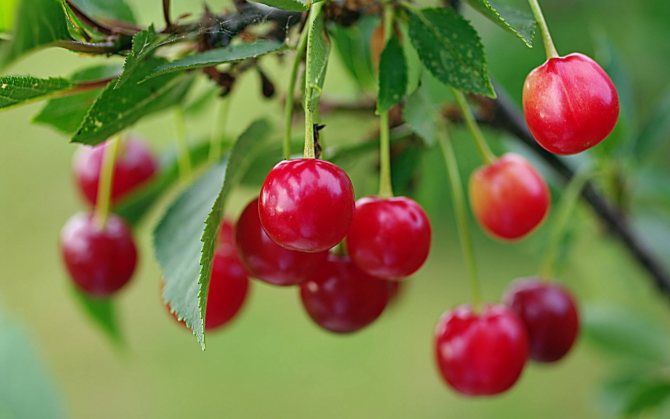

Shpanka cherry variety - a guarantee of an early and rich harvest
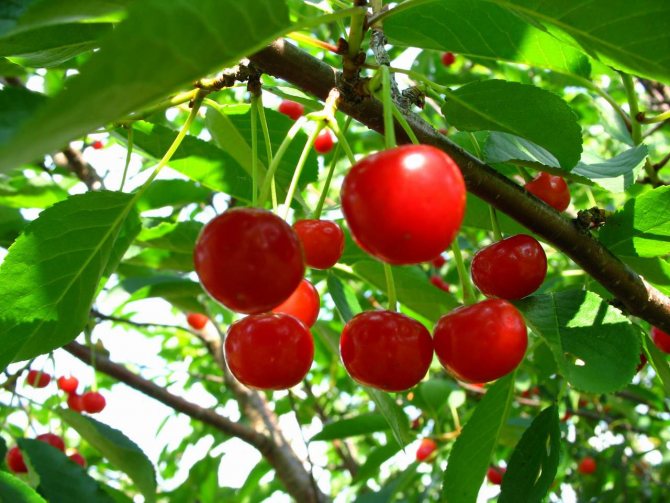

Cherry variety Turgenevka - pleasant heaviness of the harvest
Features of planting and care
It is better to lay a cherry shrub garden on a gentle slope, where there is no risk of spring stagnation of melt water. Choose an open, sunny place with sufficient area for the growth of the undergrowth. Planting and caring for bush cherries is not very difficult, but it contains several important points.
Important! On a plot nearby, it is advisable to plant other varieties of cherries (pollinators) with similar flowering periods, this will increase the yield by 2-3 times.
Soil preparation
Steppe cherry is less demanding on soil than tree cherry, but responds well to the introduction of organic and mineral fertilizers when planting.
The root system of the shrub lies close to the surface, so it is enough to prepare a fertile layer of 30-40 cm. To do this, humus (10-12 kg / m 2) and complex mineral feeding (150 g / m 2) of superphosphate are introduced under deep digging. Sowing green manure with subsequent digging at the budding phase will help improve the structure of the soil and fill it with organic matter.
Advice. It is better to dig holes for seedlings in advance, at least a month before planting.
Landing
It is important to start planting seedlings in the fall, three to four weeks before the first frost, or in the spring, before the start of sap flow:
- The pit is filled in 3-4 days with fertile soil with the addition of organic and mineral components (humus 4-5 kg, potassium salt 50 g, superphosphate 150 g, ammonium sulfate 50 g).
- Healthy young bushes with a developed fibrous root have a root collar a couple of centimeters above ground level.
- Around the seedlings, the ground is compacted with your feet. After watering, the soil settles, and the neck should be at ground level.
One of the reasons for the increased frost resistance of steppe cherries is the ability to retain snow between bushes and undergrowth. It makes sense to place the seedlings close to each other (1.5-2 x 2 m). Planting is mulched with a thick layer of dry grass or peat.
Fertilizer
With proper soil preparation in the first year, additional fertilizing is not necessary. For the next 2-3 years, one spring nitrogen fertilization (urea 20 g / m 2) is enough for digging. Further, the bushes enter the fruiting period and require a more serious introduction of nutrients: in the fall - humus for digging (8-10 kg / m 2), in the spring - superphosphate 50 g / m 2, potassium chloride 10-20 g / m 2, urea 25 d, followed by embedding.
Watering
Although bush cherry is considered not very demanding on soil moisture, it gratefully responds to timely watering with an increased yield and juiciness of drupes. Sufficient watering is considered 2-3 times per season: after flowering, during the pouring of fruits, at the end of summer. Shallow loosening is recommended after each watering 2-3 days later.
Read also The meaning of white roses as a gift for a girl
Pruning
Shrub cherry is characterized by independent formation of a rounded crown. Therefore, pruning is mainly aimed at reducing thickening and rejuvenation. Fruiting usually occurs during last year's growth, so only the extra branches growing inside the crown are removed.
Rejuvenation of cherry bushes is carried out after the growth attenuation, cutting off the skeletal branches in the places where branching stops.
Since the steppe "inhabitant" is characterized by a large amount of overgrowth, thinning should be carried out in a timely manner. The lifespan of one bush without a decrease in fruiting is about 8-10 years. To rejuvenate the planting, strong and healthy layers are left, gradually replacing the old ones.
Features of varieties for regions
IN Central Russia sMy severe frosts (below -30 degrees) are rare and short-lived. There is enough snow, and it lasts until March. In spring, recurrent frosts are an annual phenomenon. Cold snaps until mid-April occur almost every spring, so when choosing cherry varieties, you should take into account the time of its flowering. In summer, the temperature is stable, intense heat can last for several days. There is a lot of precipitation in autumn. This climate is favorable for plants. Frequent rains in summer, in warm weather, can cause the spread of fungal diseases. Varieties with average winter hardiness, resistance to infections and with different ripening periods will grow well in this region. Such as the Amorel, Meteor, Vavilov's memory, Vianok, Abundant, Delight, Leningrad black and many others.
In outskirts of Moscow the seasons are separated, changing smoothly over 2.5–3 months. In spring, recurrent frosts are frequent, which can affect early flowering plants. Summers are warm, the average temperature is 22-25 degrees, intense heat happens, it can last for several days. In some years, there is a heat of more than 30 degrees, which lasts for several weeks, but this has not become a permanent phenomenon. Stable temperature in summer, with frequent precipitation, suitable conditions for the development and spread of fungal infections. Snow usually lasts all winter. Frosts, on average, are kept at around 10-12 degrees. There are thaws and severe cold, but not for long. In autumn, frosts begin in mid-October, and snow cover may be established by the end of November. Cherry varieties with average winter hardiness and disease resistance will grow well and bear fruit in the Moscow region. There are no restrictions on the timing of ripening, berries of late species have time to ripen before autumn. Quirk, Assol, Student, Brusnitsina, Tamaris, Griot of Moscow and others will be most suitable for growing in the Moscow region.
Kuban - one of the few regions in the country where climatic conditions allow growing cherries without regard to winter hardiness, flowering time and ripening time. The southern regions are located in the subtropical zone, where citrus fruits grow and bear fruit beautifully. Winter is characterized by unstable weather, with frequent thaws and frosts. The thermometer rarely drops to -5–8 degrees, so the soil rarely freezes. Snow melts very quickly and rarely lies for several days. The warm period of the year is 9-10 months. Heat is established very quickly, the air temperature + 20 + 22 degrees in early May is a common occurrence. The summer lasts 4–5 months here. There is enough precipitation, but dry periods are frequent in the steppe regions. In the Kuban, you can grow varieties with any winter hardiness and different ripening periods. A lot of varieties of sweet cherries are grown here, which in more northern regions does not give such quality berries due to lack of heat. Varieties such as Kelleris, Novodvorskaya, Black Morel, Victoria, Anthracite other.
For Bashkiria a clear division of seasons is characteristic. Summers are hot and dry. Winter is frosty, with occasional thaws. Snow lasts up to three months. Spring and autumn pass very quickly, in just 1–1.5 months. Plants have a hard time with a sharp transition from cold to heat. There is very little precipitation in summer, but droughts and dry winds from Kazakhstan to Bashkiria are a common phenomenon. For the successful cultivation of cherries, it is best to choose varieties that are frost and drought resistant. Tall trees (over 4 m) will suffer from strong winds, so stunted and bush forms will be the best option. For Bashkiria, you can recommend such varieties as Anthracite, Fairy, Octave, Bolotovskaya, Rusinka, Biryusinka and many others.
IN Belarus the climate is mild. In winter, the average temperature is -8-10 degrees, and in summer it is kept at around +20 degrees. There are fluctuations in one direction or the other, but they do not last long.There is a lot of precipitation throughout the year. Fogs are frequent and can lead to the development and spread of fungal infections in gardens. Strong winds are not typical for the local climate. Breeding works are carried out in the Republic, including with cherries. There are many excellent Belarusian varieties that are in demand not only locally, but also in Russia and other countries. In addition to local varieties, for cultivation here you can also recommend Meteor, Kelleris, Khutoryanka, Lada, Rusinka, Ksenia other.
Recent Entries
Rose Petal Jam and Its 7 Health Benefits You Likely Didn't Know About What Fruit Are You According to the Zodiac Sign The 11 Best Grape Varieties That Will Help You Create Unique Homemade Wine
Siberia and the Urals have the most severe climatic conditions for horticulture. Frosty winters and hot summers, cold springs and the early onset of cold weather dictate certain requirements for fruit trees, including cherries. In these regions, low-growing and shrub varieties with high winter hardiness, early and medium ripening will grow and bear fruit better. Although in the southern regions of Siberia and the Urals, cherries have time to ripen in August. At the same time, in the northern regions of the region, early species during flowering may be affected by spring frosts. Local, zoned varieties are preferable, the choice of which is large enough, or choose undersized or bush forms with high frost resistance. It could be Sverdlovchanka, Biryusinka, Vianok, Zaranka, Quirk, Abundant, Ashinskaya and many others.
In the Northwest region winters are long and cold, with high snow cover. Summers are short and cool, and the proximity of the sea gives a lot of rainfall and high humidity. In spring, frosts are not uncommon even in May. Late ripening varieties do not always have time to ripen, therefore, early and medium varieties with good frost resistance and resistance to infections are preferable. The branches of tall (more than 4 m) trees can freeze or break from a large amount of snow. It is better to hibernate undersized and bushy varieties. For this region, the most suitable will be Ashinskaya, Apukhtinskaya, Bolotovskaya, Izobilnaya, Shubinka, Desirable, Leningrad black other.
In Ukraine a cherry tree is sure to grow in every home. The gardens cover large areas. Who does not know the famous Ukrainian dumplings with cherries? This is a national dish, like Siberian dumplings. The climate in Ukraine is mild, which is greatly facilitated by the proximity of the two seas. In the steppe regions, heat and drought are not uncommon in summer. Winters are not very harsh, on average -8-12 degrees. Snow in northern and mountainous regions is abundant. The seasons change smoothly, within 1.5–2 months. In the south, the warm period is longer, up to 7–8 months a year. Precipitation is frequent, but insufficient in the steppe regions. For cultivation of cherries, it is better to give preference to local varieties, which are known in large numbers. Plants with any ripening period are suitable for planting. You can choose the height of the tree based on your preferences. Belarusian varieties also grow well here. High frost resistance is not of great importance here, but attention should be paid to drought resistance. Victoria, Nord Star, Alpha, Ksenia, Black Morel, Rossoshanskaya black, Memory of Vavilov and others, will delight you with a good harvest.
On the Black Earth winters are not very cold, on average about -10 degrees. Severe frosts happen, but do not last long. In summer, the temperature is around +22 degrees. There is enough precipitation. Spring frosts are characteristic, which in some years also happen in June. In autumn, the thermometer can go into minus already at the end of September. All this dictates certain requirements for the choice of cherry varieties. The plant should have medium hardiness and resistance to infections.It is good if it is a self-fertile variety. In some years, late-ripening plants may not have time to ripen, and the earliest ones have a risk of damage by spring frosts. Amorel, Meteor, Memory of Vavilov, Khutoryanka, Lada, Radonezh, Tamaris, Octave and many more will grow well in this region.
Advantages and disadvantages of bush cherry
- increased frost resistance and drought resistance;
- low requirements for soil fertility;
- early maturing, fast-growing;
- decorative appearance during flowering;
- dense growth allows you to regularly rejuvenate the planting;
- fruiting occurs already in the 3-4th year;
- resistant to disease.
- sour fruits, often tart, often small;
- bears fruit only in an open, sunny place;
- numerous shoots require frequent thinning;
- short lifespan of one bush.
Planting bush cherries will not bring much of a hassle to the gardener. The main thing is that the site is sunny and open. Even with minimal maintenance, the annual harvest of succulent cherries will be worth the cost.
Cherry pruning is essential for crown formation. With natural growth without the intervention of a gardener, the crown of many trees can acquire a number of disadvantages: ankle, early weakening or death of the central conductor, easily breaking forks, strong thickening with an excessive number of skeletal branches, excessive tree height, instability and sagging branches.
Growing conditions of Kiku shidare
Cherry finely sawed sakura Kiku shidare grows on different soils, but gives preference to moist calcareous soils. This cherry loves well-lit, windy areas. In order for the plant to bloom profusely, superphosphate should be regularly and timely introduced into the soil.
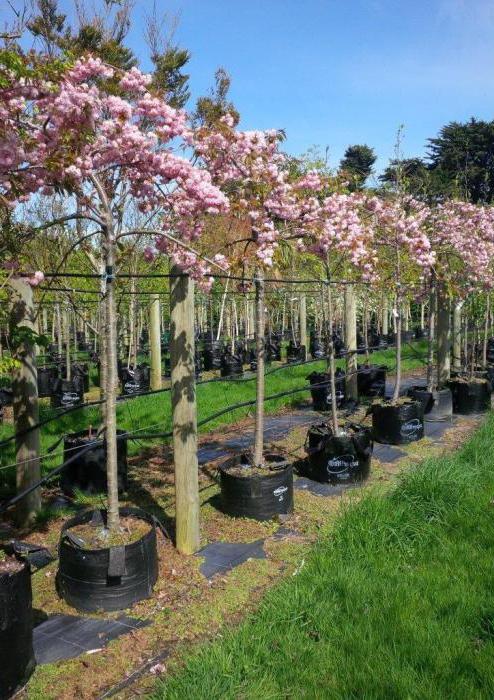

The tree of unusual beauty is used in landscaping garden and park areas. The climatic conditions of the steppes and forest-steppes are suitable for the Kiku shidare variety. Its growth is comfortable in these zones.
When to trim?
How and when is the best time to prune a tree? Many pruning guides say the best time to prune is when the frost ends before the buds begin to awaken. Kurdyumov's experience shows that pruning can be done at any time, including during sap flow. If you remove some of the branches before growing, then the remaining will get more nutrients - this is especially true for young trees. Adults hardly notice such pruning.
If there is a suspicion that the trees are frozen, then it is better to postpone pruning until it becomes clear which branches are frozen and which are healthy. This usually happens in June.
Main characteristics of the species
Those who have already planted such a cherry variety note its resistance to unfavorable temperature conditions and the ability to give a rich harvest.
Winter hardiness
The shrub calmly tolerates frosts down to -50 ° C. Although its root system can be damaged during severe frosts, it quickly recovers. Swollen cherry buds are also capable of surviving frosts.
Important! Steppe cherry is distinguished by the highest frost resistance of all fruit-bearing plants.
Drought tolerance
Due to the deep growth of the roots, this cherry variety tolerates the dry period well with a decrease in humidity to 20% and an air temperature above +40 ° C.
Fruiting and productivity
For the first time, steppe cherry begins to bear fruit in the 4-5th year after planting, the fruits continue to ripen for 35 years. Ripening period begins at the end of July. One bush can produce up to 11 kg of berries per season, and more than 10 tons of cherries can be harvested from 1 hectare.
Bush and tree cherry
By the nature of growth and fruiting, cherries are divided into bush and tree-like.
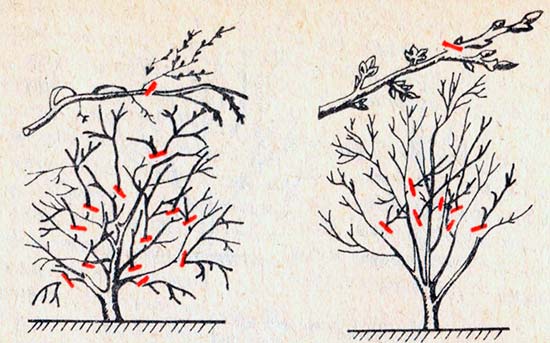

Cherry pruning: left - bush cherry; on the right - tree cherry
Tree cherries - with strong vertical growth.The predominant part of the fruit is placed on special fruit branches - bouquet (small branches with a leafy apical bud surrounded by a rosette of flower buds).
Bouquet twigs can live and bear fruit for several years. A short growth up to 50 cm long is formed on a bouquet twig from the apical buds. Some of the buds on the growth are flowering, some are vegetative. From vegetative then either bouquet twigs or long growths are formed.
When the growths are weakened (up to 20 cm), only flower buds are formed on them, there are almost no vegetative buds, and after fruiting, the branches are bare. With strong growth, on the contrary, they may not form bouquet branches for a long time. In addition, they often cannot set fruits from pollination with their own pollen (self-infertility).
Read also Beetroot in a sleeve for roasting in the oven
Bush cherries - lower, prone to weeping, bloom almost exclusively at the ends of annual growths, where flower buds are located almost along their entire length in the axils of lateral leaves.
Diseases and pests
The most dangerous diseases for ornamental cherries are fungal:
- clasterosporium disease;
- moniliosis;
- coccomycosis.
Only Sakhalin cherry is resistant to them.
If the plant is affected by a fungus, it is necessary to cut off the affected leaves and branches, then burn them. A 1% solution of copper sulfate is applied to the cut site. The whole tree is treated with 2% Bordeaux mixture.
Trees infect pests:
- the beetle and its larvae eat the roots;
- sapwood gnaw through the bark;
- cherry moth harms buds and buds;
- leaf aphids suck the juice out of the leaves.
And also cherry trees are attacked by caterpillars of butterflies, golden-tails, ermine moths, leafworms. Caterpillars are sprayed with a preparation containing Bacillus thuringiensis, the cobweb is destroyed.
Pests are destroyed with chemical insecticidal preparations. The soil in the near-trunk circle is loosened, and the weeds are destroyed.
Regular inspection of plants is carried out to prevent parasites and diseases.
And also cause great damage to the crop of birds. Sparrows, magpies, blackbirds, crows eat ripe fruits. Hanging flags, ribbons of red cloth or foil on the trees, which create a rustle that frightens off birds, helps to combat them.
Pruning technique
1) If the annual growth is short (20-25 cm), all lateral buds are flowering, vegetative bud only at the top - after fruiting, the branches are bare. On very strong (more than 50 cm) growths, on the contrary, all buds are vegetative, new branches are formed from them. The most optimal growths are 25-50 cm, usually this is the middle tier of branches.
2) Shape and cut the seedling you need from the very beginning of planting - choose 5-6 main branches with a distance of 8-15 cm between them, carefully cut off the rest unnecessary ones into a ring.
3) With each trimming, cut all branches that go inside the crown and have no development prospects. Of the two parallel branches, one is left running at a more obtuse angle from the stem and more conveniently located in relation to the neighboring ones.
4) If the remaining branches are long and thin, they are shortened by cutting off above the kidney without leaving a hemp.
5) Every year you need to increase the number of main branches and bring them to 10-15 for bushy and 6-10 for tree-like ones. Lateral branches do not need to be limited in growth if they have room to grow. Limit growth in height (no more than 2 meters) and direct the leading shoots to the side by pruning.
6) Have well-fruiting cherries with an increase of 30-40 cm, pruning consists in removing unnecessary branches. During the summer, watch the growth of shoots and pinch unnecessary ones growing in depth, etc. Each branch should be lit for most of the day, without light, flower buds will not form.
7) Treelike cherries it is permissible to shorten annual shoots during the summer, which stimulates the formation of bouquet branches from the lower buds of the cut branches.For bush cherries, it is enough to cut the growth by half once in June over the summer. When pinching young thin shoots, the tree is not wounded and the healing process occurs quickly - that's why you don't need to be limited to just one pruning in early spring. During the entire growth period, the pruning procedure is quick, natural and less painful.


Introduction
All cherry varieties, unlike other stone fruits, are divided into two large conditional groups: "bushy" and "tree-like". They differ in the type of flowering and planting of vegetative buds.
At the tree cherry
(Anadolskaya, Zhukovskaya, Podbelskaya, Amorel Nikiforova, Moscow Griot, Orlovskaya early, Rastunya, Pink bottle, Turgenevka, Black consumer goods, etc.)
flower buds are located on annual growths and bouquet branches.
Bush cherry
(Lyubskaya, Vladimirskaya, Turgenevskaya, Altai large, Ashinskaya, Crimson, Bolotovskaya, Vladimirskaya, Vuzovskaya, Kurchatovskaya, Maksimovskaya, Blizzard, Shokoladnitsa, Schedra, etc.)
- only on annual increments.
The correct pruning of cherries is done only with this feature in mind.
Many gardeners talk about the inadmissibility of shortening cherry branches (and even pruning in principle)! Indeed, if you cut it like an apple tree, without taking into account these features, then it is better to leave it growing as it is.
They start working with cherries in the second half of March, when the frost-free period is finally established. By this time, the buds swell and frozen branches become visible. All operations must be completed before the start of sap flow (the beginning of the opening of the kidneys). Late pruning can cause gum flow and weakening of the plant.
Rejuvenating Cherry Pruning
The weakening of annual growth suggests that the tree needs rejuvenating pruning, which should not be tightened.
For rejuvenation, cut the branch back to the first strong branch. If the branch is in the lower part of the crown, cut to a branch oriented upwards. You also need to remove all weak, non-branching, broken, dry branches.
After such pruning, strong tops will appear, which, in turn, also need to be shaped and cut, and unnecessary ones removed as early as possible.
We recommend watching a video about pruning cherries:
Wintering of small-sawed sakura
In order for the finely sawed cherries to successfully overwinter, at the end of summer, any feeding of trees with fertilizers containing a large amount of nitrogen stops. But phosphorus and potassium will help to endure the winter easier. Therefore, fertilizers with their content must be applied. Before wintering, it is necessary to saturate the soil with moisture. To do this, the tree trunks are watered abundantly. As soon as the first frosts come, the stems and crowns are tied. For this, a covering material is used.
To protect the trunks from sunburn and cracks, they need to be whitewashed or tied with agrofibre. With the onset of spring, while there is still no movement of the juice, you need to prune the branches in order to save the crown from thickening. Instruments and sections are disinfected. When the wounds dry up, they should be treated with a pitch.
Varietal characteristics
In mature age, the plant reaches 2.5 m in height, has a multi-stemmed wide and medium thickened crown. The trunks of the shrub are covered with a grayish bloom, the bark is smooth. Branches of medium thickness, hanging down, brown. The internodes are short. The kidneys are tapered.
Leaves of medium length, dark green color, at the base have a rounded shape at the end - pointed. The edges of the plate are serrated.
It blooms with white small flowers, collected in a bunch of 3-4 pcs. The diameter of the flowers is 20-25 mm. The petals are oval in shape.
Fruit
The berries are round, slightly flattened, dark red in color. Fruit length is about 14 mm, width - 12 mm. The average weight is 3.5-4 g. The fruit contains a not too large oval-shaped stone - about 0.15 g.
Ripening occurs at the end of June. The average yield of a bush is 6-12 kg, depending on the region of cultivation and the characteristics of care.
In the first decade of June, the growing season ends, and by the end of November, the berry shrub sheds its foliage.
Root system
This plant develops a horizontal root system that grows up to 50-60 cm deep from the soil surface. The length of the roots in adult specimens can reach 6-8 m. Therefore, this culture has an increased resistance to drought, which can feed moisture from the deep layers of the soil.
As shrubs grow, they become overgrown with root shoots, which have a superficial root system. Therefore, the loosening procedure should be carried out carefully so as not to damage them. In addition, you can use root suckers for further breeding of new specimens.
Whitewash
In early spring, it is advisable to protect the trunk from sunburn, for this, immediately after removing the covering material, the trunk must be painted with garden red or whitewashed.
It is allowed to use agrofibre, however, try to prevent water from accumulating in the space between the agrofibre and the trunk, otherwise all kinds of rot may occur.
Reference by topic: Shrub cherry - planting and care
Other varieties of ornamental cherry for garden decoration
Small-sawed cherry is a very beautiful plant, but there are a number of similar crops that can complement it and create a garden of various types of cherry blossoms. Bell cherry is also often called winter sakura. This variety has large, lilac-red buds that can be collected in inflorescences or be located one by one. This decorative cherry got its name due to the peculiarities of the buds. They do not open completely, which is why they slightly resemble bells. This variety is relatively cold resistant. Although, if the temperature drops below -17 degrees, the described sakura may die. Bell cherry in cold climates is most often cultivated as a container plant. In cold regions, Kuril cherry, which belongs to the group of ornamental trees and shrubs, develops well. This species is small in size and hardy. It begins to bloom in May, the buds are light, almost white. It looks very decorative in autumn, when the foliage becomes fiery orange. The popular varieties of Kuril cherries are Brilliant and Ruby. Ornamental Cherry Brilliant is an attractive, upright shrub that can grow up to two meters in height. The crown is dense, but grows slowly. Buds are large, white, appear before foliage. The foliage is elongated, pointed, rich green. A distinctive feature of such a plant is the presence of fruits. They are quite small and rather dark in color, but they can be eaten. Ruby has a strong and pleasant aroma that comes from the pale pink buds. The shrub reaches a height of 2.5 meters and blooms profusely. The plant develops slowly and bears fruit with edible small black fruits. Saw cherry, which is also called Tibetan, is a large shrub that has several stems. Cultivated in small areas, tolerates urban gas pollution well. The foliage resembles willow leaves, green, often with a silvery sheen. A feature can be called the glossy texture of the stem and shoots, which have a reddish tint. If this plant is illuminated by the sun, it gives the impression of a glow. The buds are small, white, sometimes with a purple tint. Flowers appear at the same time as foliage.The main attraction of this variety is considered to be the bark and dense foliage. This plant also bears fruit. Although, cherries have a specific, not too pleasant taste and are more often used for preparations or as decoration.
While watching the video, you will learn about caring for cherries.
Selection work and research of finely sawed cherries are carried out constantly. The purpose of these works is to increase frost resistance and winter hardiness, expand the cultivation area. Perhaps soon the plant will be able to grow in medium-sized horticultural regions.
Attention super FLY!
Cherry
Interesting to read:
- Varieties of geranium: popular interior and landscape varieties
- Women's happiness or spathiphyllum: varieties and types
- Which tree blooms earlier than others: details of the earliest specimens
- Features of pruning a cherry tree in spring and plant care
- Zelkva: description of the plant and characteristics of the species
- Cercis canadian: description, basics of cultivation
- Features of caring for Japanese cherry sakura and methods of its reproduction
- How to grow wisteria: basic care, pruning wisteria in the fall
- Melitopol early sweet cherry: description of the variety, feeding, reviews of gardeners
Preparing for winter
After all the sanitary and preventive measures, work is carried out to shelter the cherries for the winter. This is especially important for trees under 4 years old. First of all, you need to cover the trunk circle with a 5-7 cm layer of mulch. This requires loose material: peat, sawdust or humus.
The peeled stem must be whitewashed. To do this, use ready-made means: "Protection" or "VS-551". You can prepare a protective mixture yourself.
Structure:
- clay 1 kg;
- lime 1 kg;
- mullein 300 g;
- copper sulfate 200 g
The components are dissolved in warm water to a thick sour cream. This mixture provides versatile protection: the smell of mullein scares away rodents, copper sulfate inhibits the development of fungal spores, lime and clay prevent sunburn.
A week before frost, the trunk of trees is covered with warm non-woven fiber. Young seedlings are bent to the ground and covered with spruce branches. It is important to remove the covering material after stable warming. Prolonged exposure to warm material leads to podoprevanie shoots and roots.
Expert opinion
Yulia Yurievna
I have a large garden and vegetable garden, several greenhouses. I love modern methods of plant cultivation and soil mulching, I share my experience.
Ask a Question
Proper care of the shrub
Steppe cherry care is:
- timely watering;
- loosening the soil to a depth of 4-5 cm;
- top dressing;
- pruning.
In order for the steppe cherry to grow well, it is necessary to weed it. By loosening the soil, the shrub will receive more oxygen. However, when carrying out such a procedure, it is important not to injure the roots.
In order for the cherry to bloom actively and give tasty fruits, it is necessary to fertilize it 3-4 times a season. The plant positively perceives products containing superphosphate. I recommend bringing them in in the fall. Fertilize steppe cherries with mineral additives: add wood ash.
Thanks to such means, the plant will more actively form shoots. Add water after the cherry has faded, then during the period of fruit formation. Be sure to water the shrub before feeding it.
Steppe cherry needs a corrective haircut. It is better to carry out this procedure in early spring. It is important to spray the plant on time using insecticides. Such a measure will avoid pests.
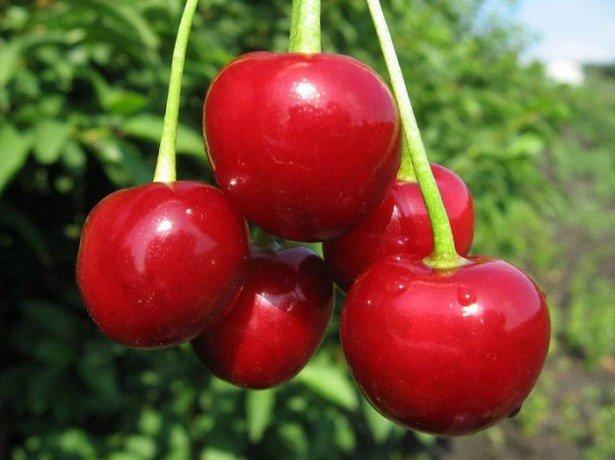

How to propagate felted cherries
If there is a problem with the purchase of seedlings, you can grow a tree yourself.
Underwire
Basically, felt cherries are propagated by planting seeds.
They should be collected, rinsed and dried a little. Towards the end of summer, place the bones in damp sand and leave them until late autumn in a cellar or any other cool place.Around October, the bones prepared in this way are planted in the soil, making grooves and deepening them by 2 cm.


Children
And in the spring you can already see the first long-awaited sprouts. During the first year of development, seedlings grow up to half a meter and in autumn or spring they can be planted in a permanent place.
Cuttings
In July, cut off cuttings from a mature tree. The cut stalk itself should be no shorter than 15 cm and taken from a branch of 2-3 orders of magnitude. Then you need to put them in water in which any growth regulator is dissolved:
- Heteroauxin;
- succinic acid;
- Kornevin;
- Zircon;
- Epin.
Leave it on for 15 or 18 hours. The next step is to plant the cuttings in the soil to a depth of 2 cm covered with bark + 1 cm of the green section of the shoot.
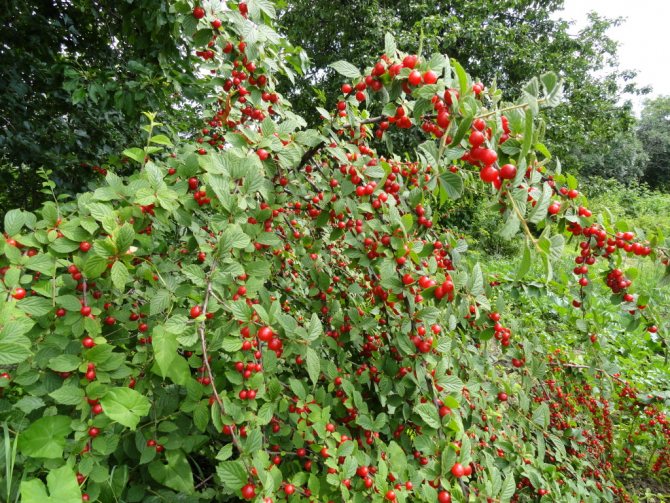

Cherry Princess
Then the cuttings must be covered with a film on top, creating greenhouse conditions for them.
Further care consists in protecting the sprouts from excessive overheating, especially in the first month of planting, and from drought.
Already after 14 - 15 days they have adventitious roots, and after 30 days - difficult to root.
Layers
In early spring, near a suitable shoot, dig a small hole up to 10 cm deep. Put the shoot in it and attach it to the ground with staples. Then it remains to sprinkle it with earth and do not forget to water abundantly throughout the summer.
When autumn comes, young roots will appear on the handle. For further planting, it can be divided into parts or left intact.
If you properly plant varieties with different ripening periods around the site, you can feast on and harvest these wonderful and fragrant berries for the winter. And how much delight the felt cherry blossoming under the window in spring will cause!
Where is it better to plant cherries on the site
Regardless of the variety, it is better to plant the crop in an area with a slight elevation. If there is no such place, an artificial mound is poured out of the ground. This is necessary so that rainwater does not accumulate at the roots and cause them to rot.
In addition, these plants love sunlight, and while traditional varieties do fine with a little shade, it is best to plant in a well-lit area whenever possible.
The best place to plant would be an area near a house or fence. This will protect the tree from the cold wind, and the additional accumulation of snow in winter will ensure the preservation of the culture.
Soil preparation
Prepare the soil before planting. This will ensure good growth of the tree in the early stages of cultivation and abundant fruiting in the future.
Organic fertilizers and mineral fertilizers are applied to the soil. Acidic soils are additionally limed. It is advisable to prepare the holes in the fall if spring planting is planned. Fertilizers are applied immediately before planting. However, in this case, nitrogen-containing fertilizers are not used, as they can cause root burns.
Bird cherry (Sweet cherry)
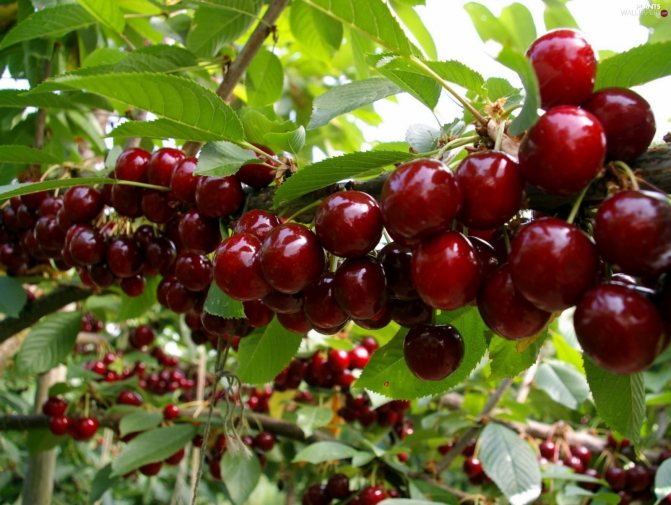

Prunus avium (Latin) is one of the original species that contributed to the origin of the common cherry. The variety is known in the wild in the Mediterranean, Central and Southern Europe, Moldova, the Caucasus and Ukraine.
- It is a large sparsely branched tree (in nature up to 25 m in height), the leaves are large, oval or obovate.
- The fruits of wild cherries are small - up to 1.5 g, yellow-pink, red or almost black, sweet with bitterness and without bitterness.
On the basis of wild-growing forms of sweet cherry, a huge number of related varieties have been bred for a number of centuries.
Pros and cons
The advantages of growing steppe cherries:
- Resistant to frost and drought.
- No need for careful bush care.
- Picky soil.
- A bountiful harvest.
- Delicious fruits.
- Long lifespan.
- Ease of breeding and reproduction.
- The ability to use for decorating the site.
Negative aspects of growing a plant:
- The fruits ripen late and are poorly stored.
- The shrub begins to bear fruit no earlier than 4 years after planting.
- The crown must be trimmed regularly.
- Can't stand the shadow.
- Needs cross-pollination.
- It is affected by pests, coccomycosis and clotterosporia.
Thus, by planting a steppe cherry on the site, you will not only ennoble it, but you will also be able to regularly get a rich harvest. An important advantage is the undemandingness of the plant and the ability to grow in frosty and arid regions. However, do not forget to prune the shrub and treat it from pests and diseases.
Choosing a small-sawed cherry seedling
We advise you to buy seedlings in the spring, as well as to plant, because this is a stone fruit crop, which no one recommends to plant before winter. When choosing a seedling, take a good look at it, there should be no damage on the roots, they should not be torn off, dried.
The aerial part should also be alive, dry, without damage to the bark. Take a closer look at the root collar, in finely sawed cherries this is a weak point: is there
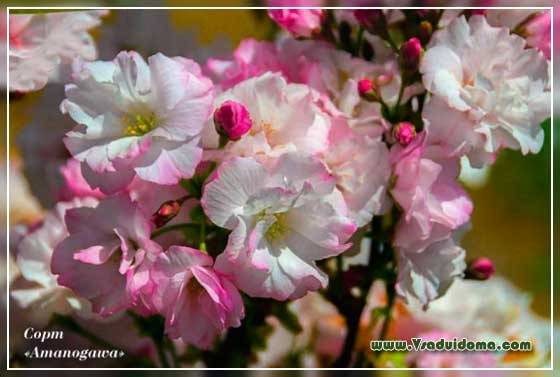

signs of decay. Only when you are sure that the seedling is "alive and well" can you buy it.
What conditions does culture require?
To grow a crop and get a full harvest, it is worth choosing a site for planting correctly. Shrub cherry needs the following conditions:
- good illumination;
- no drafts - they destroy the crown and lead to the spread of infections;
- deep location of groundwater - this helps prevent root flooding and avoid the development of fungal diseases;
- slight elevation - helps prevent flooding and moisture build-up during rainy periods.
conclusions
- Glandular cherry is an ornamental crop that is not used for growing fruits. The decorative performance is high all year round.
- The tree gives few berries, they are sour-bitter, they are not especially used for food.
- The main activities for tree care are watering, feeding, pruning. Pruning must be done, the main thing is not to be too zealous.
- It is best to use one- and two-year-old seedlings for planting. In regions with cold winters, the plant is transferred to open ground in the spring, when return frosts pass.
Planting finely sawed cherries
As for the landing, then there is nothing complicated. Make holes in the soil, 25-30% larger than the volume of the root system, be sure to put drainage (pebbles, broken brick, expanded clay) in the base with a layer of 3-4 cm, and on top throw a couple of shovels of the nutrient mixture (one part of the peat , river sand, humus, topsoil and a tablespoon of nitroammofoska).
Water the hole by pouring out a bucket of water, and place the seedling root system in the moist soil, gently spreading the roots. After that, fill the hole with soil, compact it well, pour it with a bucket of water and mulch the surface with peat or humus with a layer of a couple of centimeters.
The best cultivars for the regions
The best varieties of felt cherries are presented in the State Register of the Russian Federation, but new ones appear every year, among which there are self-fertile, resistant to many diseases of stone fruit cultivars.
Felt cherry suitable for growing in Northwest Russia
Here, most often the berry bush suffers from recurrent frosts, therefore, summer residents pay special attention to the most resistant to low temperatures cultivars - Okeanskaya Virovskaya, Tsarevna, Natalie, Delight. The most dangerous in a damp climate is coccomycosis; as a result of breeding work, the Krasavitsa and Morning varieties have become popular here.
Varieties for Central Russia and the Volga region
The most unpretentious and worthy of the summer residents of the Chernozem region are the Osennyaya Virovskaya, Children's and Delight varieties. But the variety Natalie, Tsarevna and Alice can be considered no less profitable in terms of yield.
The Alice variety looks very impressive at the time of flowering, it is he who grows on our site. But in terms of fruiting, it is impossible to name the exact indicators of yield, year after year is not necessary.Often the fruits ripen on some shoots located closer to the hedge. Perhaps the buds freeze out, the bush grows in an open area near the road as a decorative element, therefore, we do not achieve maximum fertility. I really want to plant a white-fruited felt cherry, since this variety is spoken of as the most frost-hardy and picky. But we have not yet managed to find a zoned original in our Chernozem region, and seedlings from Siberia do not take root.
The choice of gardeners of the Far East and Siberia
In the harsh climate of Western and Eastern Siberia and the Far East, they choose the novelty Damanka, the classic variety of Natalie felt cherry. There are many good reviews about Okeanskaya virovskaya, varieties Ogonyok, Belaya, Salyut and Skazka.
Video: felt cherry in Siberia
Fruit
This plant bears fruit with abundant small, juicy, sweet and sour berries. The diameter of one berry is 1-2 cm. Fruits are black or red in color. In almost all varieties, they are edible. The harvest ripens in mid-July.
With good growing conditions and proper care, 10 to 20 kg of berries can be harvested from one plant.
Delicious compote and jam are obtained from the fruits. The leaves are used as a spice for making pickles and pickles.


Gardening tips
In central Russia, seedlings are best planted in the spring, before the buds are swollen. This usually happens at the very end of March, during this period young plants are actively adapting to the environment. If you plant in late autumn, then there is no guarantee that the plants will take root. It is better to purchase seedlings also in spring, when there is a large selection: a huge assortment of planting material is offered for sale in nurseries.
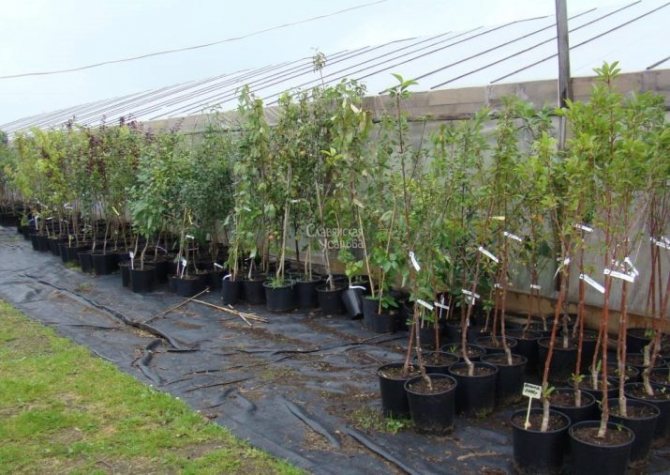

Cherry seedlings can easily "overwinter" in a private household. In this case, the seedlings must be slightly instilled. Around the trunk (11 cm indent), mulch is made from the following components:
- humus;
- compost;
- hay;
- grass.
The layer thickness should not be more than 10 cm.
If the winter was too cold, then part of the root system may suffer, in this case it is necessary to fertilize with a solution of urea (0.6%) immediately after the flowering period. After a couple of weeks, one more top dressing should be done, then the probability is high that the plant will come to life again.
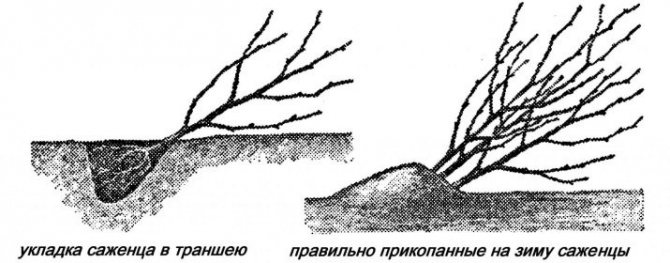

What is the difference between felt cherry and ordinary cherry
Felt cherry: varieties for the Moscow region
Although the felt cherry (in Latin - Prunus tomentosa) is called cherry, it is only distant relative and has little in common with it, because it belongs to the type of plum. You should also know that ordinary cherries or sweet cherries cannot be crossed with felt cherries, therefore, as pollinators, they are not suitable for each other. And also they do not have compatibility when grafting grafts.
Felt cherry begins to bloom two weeks earlier. Its berries have:
- sweeter taste;
- more organic acids, carbohydrates, vitamins C, B, PP;
- other beneficial substances: anthocyanins, flavanols and polyphenols.
It is resistant to coccomycosis, which can damage up to 80% of the fruits of common cherries.
The soil
Suitable soil for planting is sandy or loamy.
But absolutely not suitable:
- overly moist soils;
- rich in peat;
- places with standing water. This will negatively affect the growth of the tree, its productivity and the ease of wintering, and often causes the death of the tree;
- acidic soils. To correct the situation, lime can be added to the soil.
The landing site must also be chosen wisely: on a hill, in the sun.

